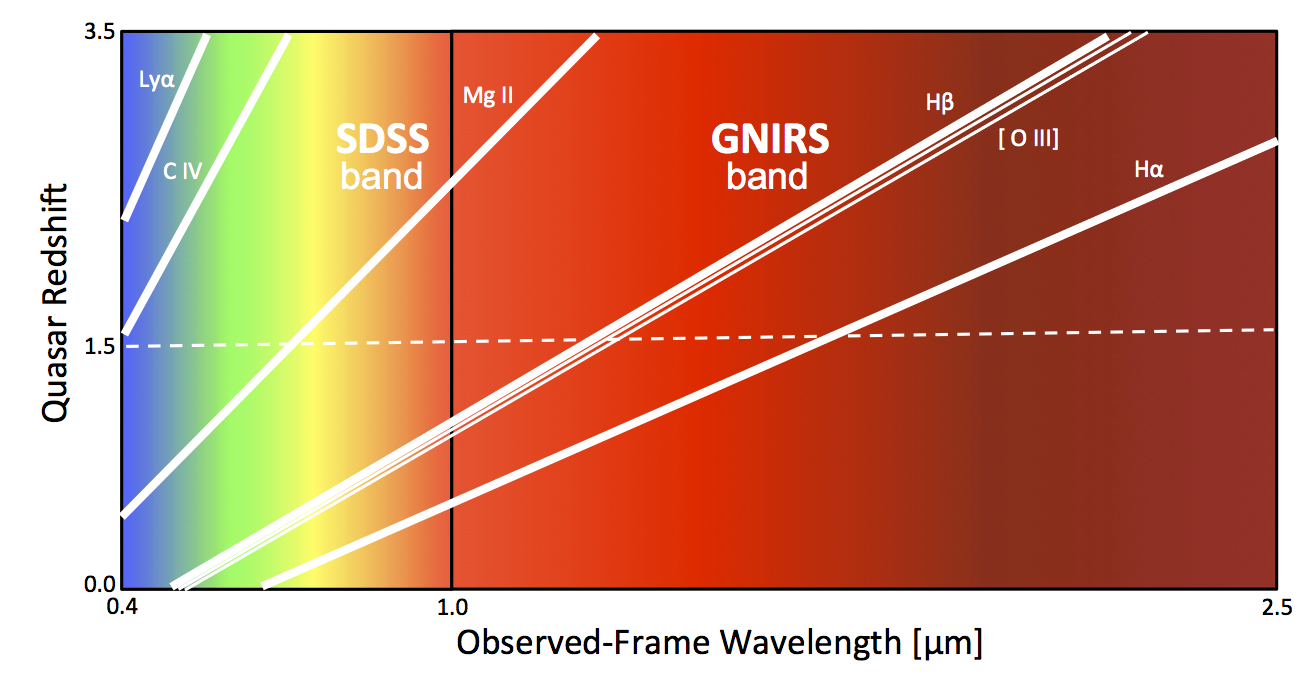Principal Investigator: Ohad Shemmer, University of North Texas
Program Summary:
Our current understanding of supermassive black hole (SMBH) growth in the distant universe is compromised by the lack of key diagnostic rest-frame optical emission lines in quasar spectra. As a consequence, our view of how SMBHs and their host galaxies mutually coevolve during the peak of quasar activity is biased and incomplete. We will therefore obtain high-quality GNIRS spectroscopic observations, in the 1.0-2.5 micron band, for a uniform sample of 416 Sloan Digital Sky Survey (SDSS) quasars at redshifts between 1.5 and 3.5. This project will more than double the existing inventory of near-infrared spectra of luminous quasars at these redshifts. We will determine the most accurate and precise quasar black hole masses, accretion rates, and redshifts, and use the results to derive improved prescriptions for UV-based proxies for these parameters. We will make our data immediately available to the public, provide reduced spectra via a dedicated website, and produce a catalog of measurements and fundamental quasar properties. The improved redshifts will establish velocities of quasar outflows that interact with the host galaxies, as well as tighten measurements of small-scale quasar clustering. Furthermore, our measurements will facilitate a more complete understanding of how the rest-frame UV-optical spectral properties depend on redshift and luminosity, and test whether the physical properties of the quasar central engine evolve over cosmic time. The next generation of cosmological surveys will generate millions of optical quasar spectra, the analysis of which will greatly benefit from the prescriptions developed in this investigation, an invaluable Gemini legacy.

Figure Caption: At sufficiently high redshifts, several prominent quasar emission features (white solid lines) are no longer detectable in the optical spectral range, represented here by the SDSS band that extends between approximately 0.4 micron and 1.0 micron (solid black line). For the broad Hbeta and narrow [O III] lines, that are rich in diagnostic power, this occurs above redshift 1, including the era of fast quasar growth. Our GNIRS spectroscopic survey will more than triple the observed spectral band, allowing us to observe these and other emission lines in a uniform sample of 416 SDSS quasars at redshifts between 1.5 (dashed line) and 3.5. The available SDSS spectra of these sources, which cover at least the rest-frame ultraviolet C IV emission line, will enable us to establish connections between optical and ultraviolet indicators of fundamental quasar properties while more than doubling the statistics at such high redshifts.
Co-Investigators:
- Michael Brotherton, University of Wyoming, USA
- Ileana Andruchow, Universidad Nacional de La Plata, Argentina
- Todd Boroson, Las Cumbres Observatory, USA
- Niel Brandt, Pennsylvania State University, USA
- Sergio Cellone, Universidad Nacional de La Plata, Argentina
- Gabriel Ferrero, Universidad Nacional de La Plata, Argentina
- Sarah Gallagher, University of Western Ontario, Canada
- Richard Green, University of Arizona, USA
- Joseph Hennawi, University of California Santa Barbara, USA
- Paulina Lira, Universidad de Chile, Chile
- Adam Myers, University of Wyoming, USA
- Richard Plotkin, ICRAR-Curtin, Australia
- Gordon Richards, Drexel University, USA
- Jessie Runnoe, University of Michigan, USA
- Donald Schneider, Pennsylvania State University, USA
- Yue Shen, University of Illinois at Urbana-Champaign, USA
- Michael Strauss, Princeton University, USA
- Chris Willott, NRC Herzberg, Canada
- Beverley Wills, University of Texas at Austin, USA